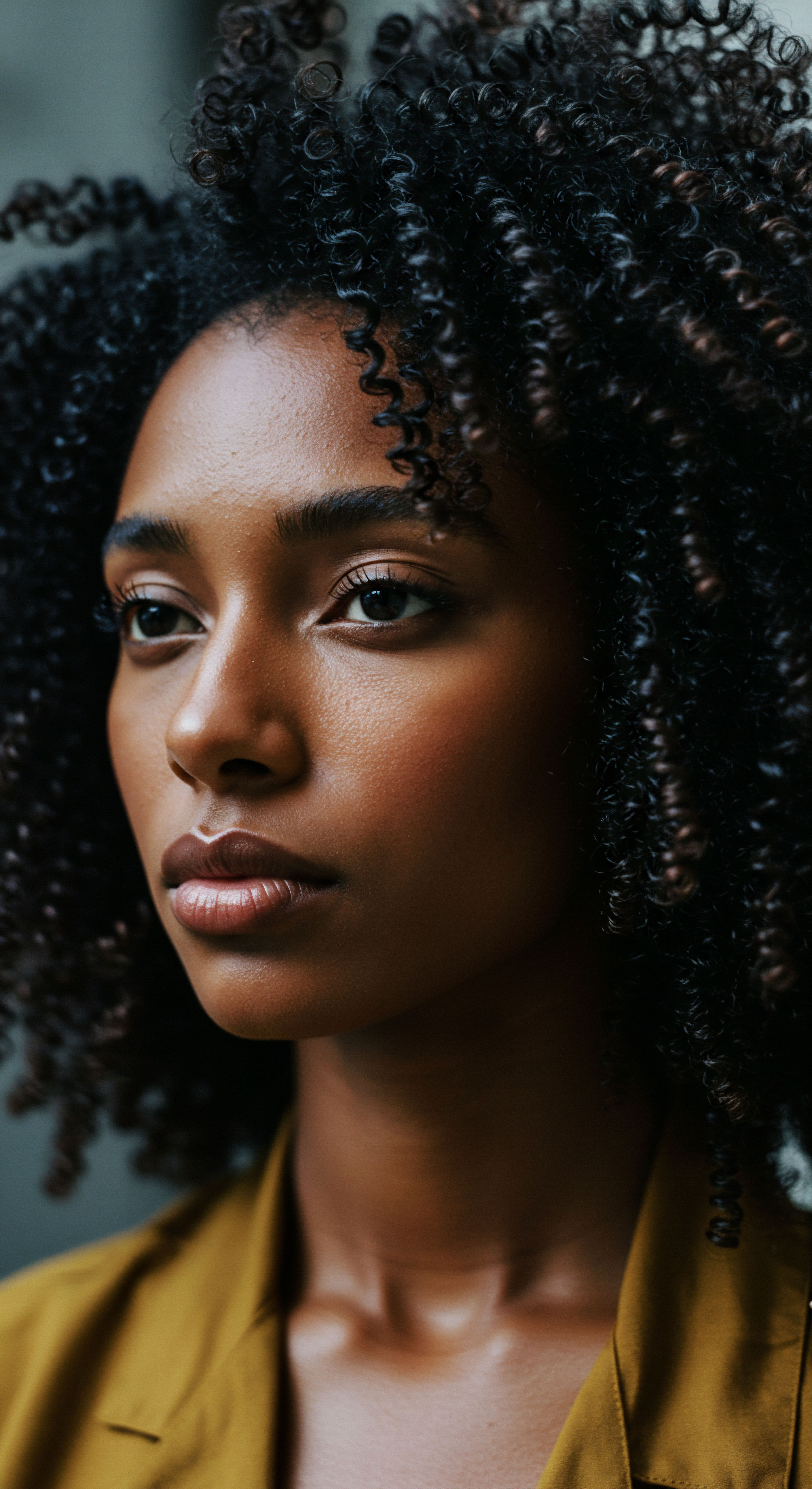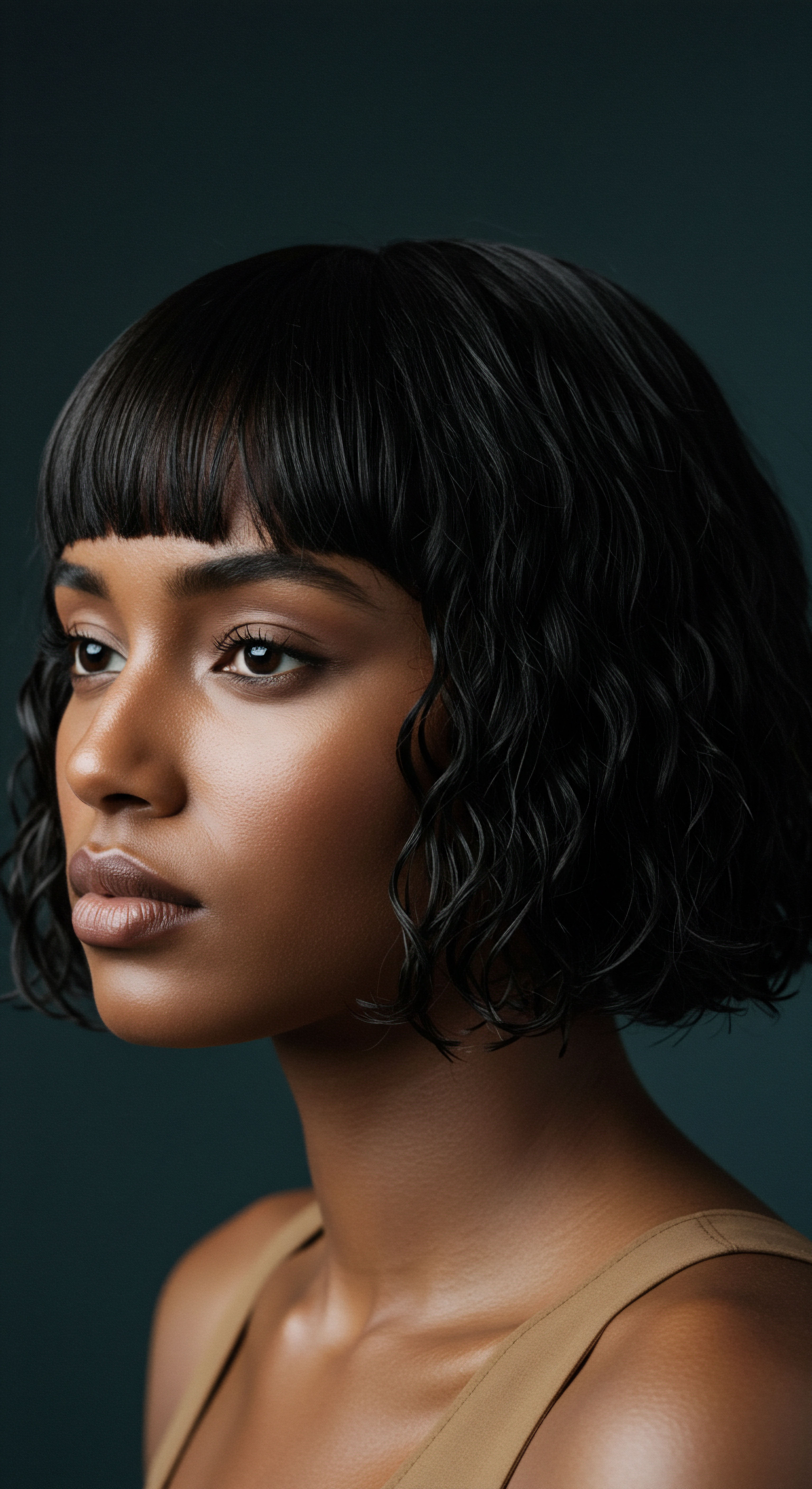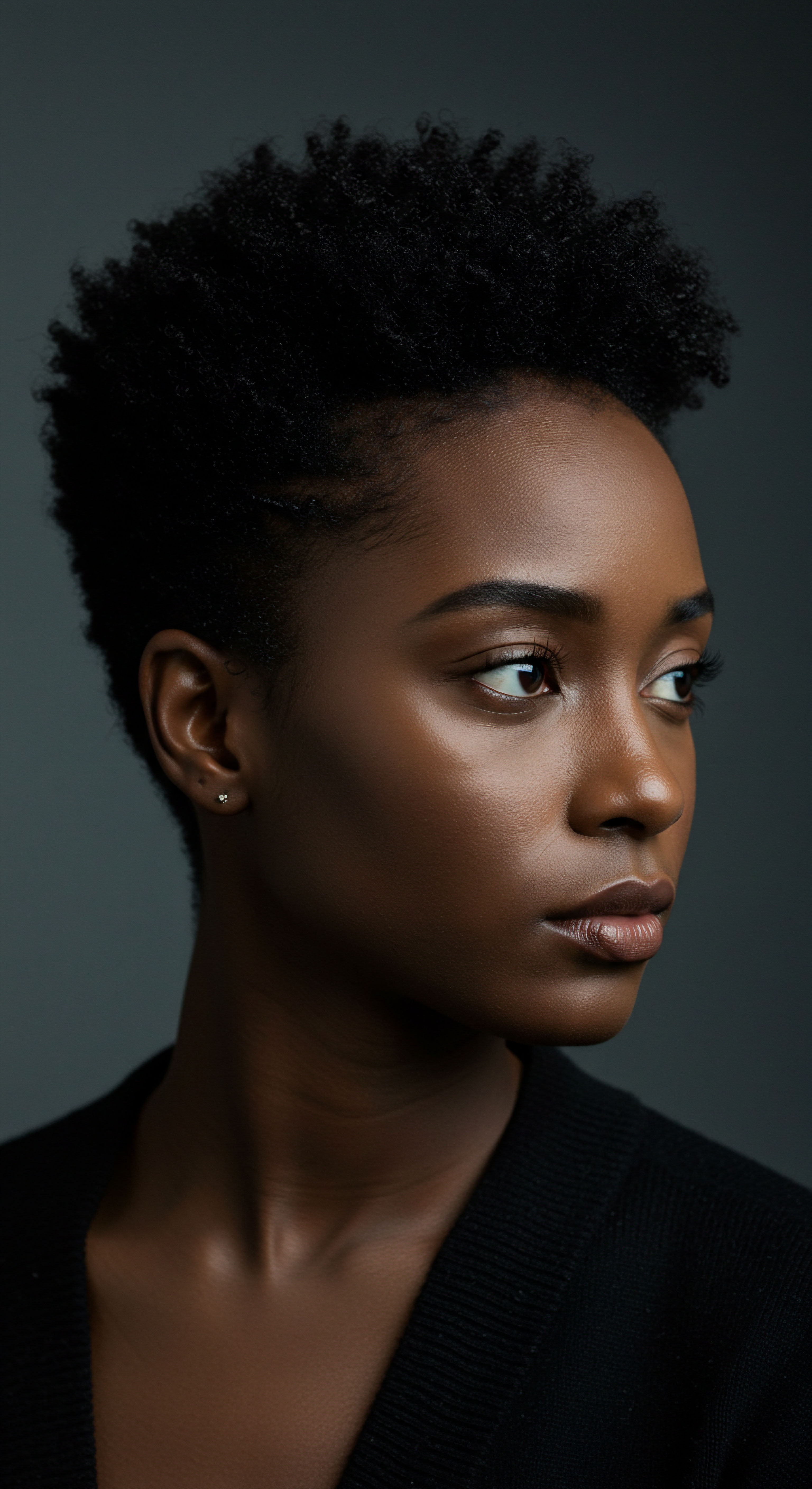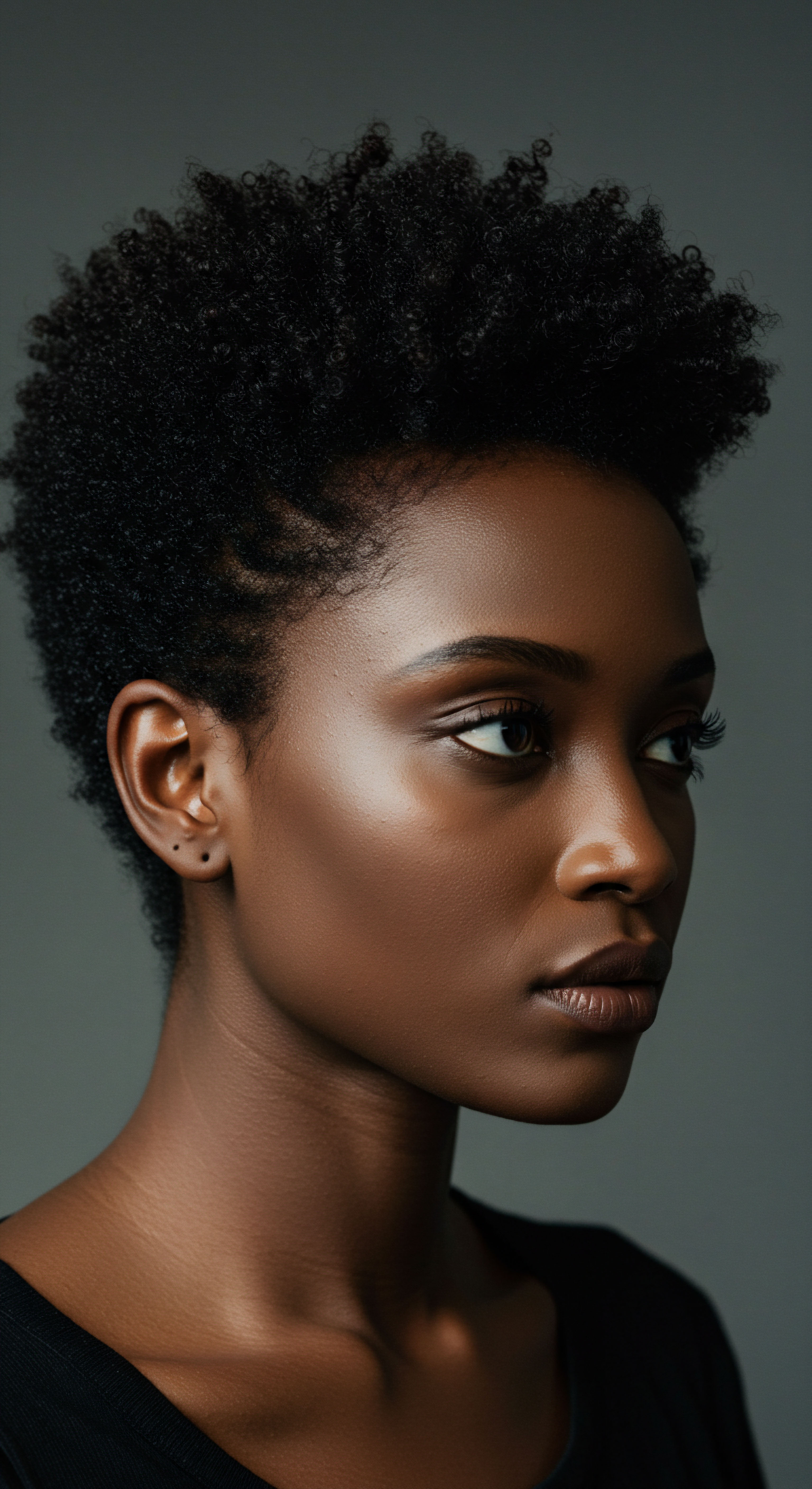
Roots
The gentle caress of a misty morning, the sudden burst of a summer rain, or even the quiet steam from a warm bath — our hair, in its myriad forms, responds. This response is not merely a surface phenomenon; it speaks to an ancient, fundamental dialogue between the strands and the very water that gives life. To truly comprehend how hair draws in moisture, we must first look to its core, the deep-seated structures that orchestrate this delicate exchange. Each strand, a marvel of biological engineering, possesses an inherent capacity to interact with its aqueous surroundings, a characteristic that shapes its very existence and how we care for it.

Hair’s Inner Landscape
At its heart, a single hair strand is a complex arrangement of specialized cells and proteins. The outermost layer, the Cuticle, resembles overlapping shingles on a roof. These tiny, transparent scales typically lie flat, providing a protective shield. Beneath this external guard lies the Cortex, the thickest part of the hair shaft, composed primarily of bundles of keratin proteins.
These proteins are responsible for hair’s strength, elasticity, and color. Some hair types also contain a central core, the Medulla, though its exact function in moisture absorption is less understood and it is not always present in all hair types.
The remarkable ability of hair to absorb water stems from its hygroscopic nature. This means hair can readily exchange water molecules with the surrounding environment, whether it be humid air or direct liquid contact. The primary actors in this molecular exchange are the keratin proteins within the cortex. These proteins contain specific sites, particularly hydrophilic (water-attracting) amino acid residues and peptide groups, that eagerly bond with water molecules.
Hair’s intrinsic capacity to interact with water is a testament to its complex biological design, with each layer playing a role in this vital exchange.

The Cuticle’s Dance with Water
When hair encounters water, the cuticle, that outer protective layer, begins its subtle transformation. The individual cuticle scales, normally pressed flat, can gently lift. This slight opening provides pathways for water molecules to enter the inner cortex.
The degree to which these scales lift and separate is influenced by factors such as hair health and environmental conditions. Damaged cuticles, with already raised or missing scales, allow water to enter and exit with less resistance, impacting the hair’s overall moisture balance.
The interaction of water with the cuticle is a dynamic process. Consider the visual of a pine cone opening and closing with changes in humidity; while not a perfect parallel, it helps conceptualize the cuticle’s response. A healthy, intact cuticle serves as a more regulated gatekeeper, permitting a measured absorption of water while also helping to retain it. When this gate is compromised, the hair becomes more susceptible to rapid moisture fluctuations, leading to conditions like frizz or excessive dryness.

Water’s Journey into the Cortex
Once past the cuticle, water molecules move into the cortex, the very core of the hair strand. Here, the primary interaction occurs with the keratin proteins. These proteins, arranged in complex polypeptide chains, are held together by various bonds, including temporary Hydrogen Bonds. Water molecules, with their strong hydrogen-bonding capabilities, disrupt these existing bonds within the keratin structure.
This disruption allows the hair shaft to swell. Hair fibers can absorb a significant amount of water, up to 30% of their weight. This swelling increases the space between the keratin proteins, making the hair structure more flexible and mobile. This phenomenon is precisely why wet hair is more pliable and can be reshaped during styling; as the hair dries, the hydrogen bonds reform, locking the new shape into place.

What Happens When Hair Swells?
The swelling of hair from water absorption is not without consequence. Repeated cycles of swelling and shrinking, often referred to as Hygral Fatigue, can weaken the hair over time, making it more prone to damage and breakage. This is particularly relevant for textured hair types, which often have unique structural characteristics that influence their interaction with water.
Understanding the foundational anatomy and how water interacts with each layer provides the bedrock for comprehending why certain care practices are so vital. It explains why a gentle approach to wet hair, and products designed to support cuticle integrity, are cornerstones of maintaining hair health.
| Hair Component Cuticle |
| Role in Moisture Absorption Outermost protective layer, regulates water entry and exit. |
| Impact of Water Scales lift, allowing water to enter; damaged cuticles permit faster absorption and loss. |
| Hair Component Cortex |
| Role in Moisture Absorption Primary site of water absorption, composed of keratin proteins. |
| Impact of Water Water disrupts hydrogen bonds, causing swelling and increased flexibility. |
| Hair Component Lipid Layer |
| Role in Moisture Absorption Surface barrier, helps repel excess water and retain internal moisture. |
| Impact of Water Intact layer reduces water penetration; compromised layer leads to dryness and porosity. |
| Hair Component The intricate relationship between hair's physical components and water dictates its hydration state and overall health. |

Ritual
Having explored the deep-seated mechanisms of how hair draws in moisture, our focus now shifts to the daily and periodic practices that shape this interaction. These practices, passed down through generations or refined through modern understanding, are more than mere routines; they are rituals, each step a mindful gesture toward sustaining hair’s inherent vibrancy. To truly appreciate how hair absorbs moisture in a practical sense, we consider the conscious choices we make in its care, from the very first wash to the quiet moments of nightly protection.

The Significance of Porosity
The capacity of hair to absorb and hold onto moisture is often described by its Porosity. This characteristic is largely determined by the condition of the cuticle layer and the overall health of the cortex.
- Low Porosity Hair ❉ This hair type has tightly closed cuticle scales, making it resistant to moisture absorption. Water and products tend to sit on the surface rather than penetrating easily. Such hair can take a long time to dry and may feel stiff if not properly moisturized.
- Medium Porosity Hair ❉ With cuticle scales that are neither too tightly bound nor too open, this hair type generally absorbs and retains moisture well. It is often considered the most balanced and requires less intensive care to maintain hydration.
- High Porosity Hair ❉ Characterized by raised or gapped cuticle scales, this hair readily absorbs moisture. However, it also loses moisture just as quickly, often leading to dryness, frizz, and breakage. High porosity can be a natural trait or a result of damage from chemical treatments, excessive heat, or environmental factors.
Understanding your hair’s porosity is a cornerstone of effective moisture management. It guides the selection of products and techniques that will either encourage or regulate water absorption, ensuring optimal hydration without oversaturation.

Cleansing and Conditioning Practices
The initial steps in any hair care ritual—cleansing and conditioning—profoundly influence moisture absorption. Shampoos, particularly those with strong surfactants, can remove not only impurities but also the hair’s natural lipid barrier, which is essential for moisture retention.
Conditioners and masks play a vital role in replenishing lost lipids and smoothing the cuticle. Products containing ingredients like ceramides, fatty acids, and plant-based oils act as natural sealants, helping to prevent moisture loss and improve elasticity. When applied to damp hair, these products create a protective film that helps the hair hold onto the water it has absorbed, rather than allowing it to evaporate too quickly.
The mindful selection of cleansing and conditioning products forms a crucial part of a hair care ritual, influencing how well strands receive and retain life-giving moisture.

How Does Product Application Aid Moisture Absorption?
The way products are applied can significantly impact their efficacy in aiding moisture absorption. For hair with low porosity, applying gentle heat (such as a warm towel or steamer) during deep conditioning can help lift the cuticle scales, allowing beneficial ingredients and water to penetrate more deeply. For high porosity hair, layering lighter, water-based products followed by heavier creams or oils can help seal the open cuticles, locking in moisture and preventing rapid dehydration.
Even the simple act of detangling can affect moisture absorption. Combing wet hair requires care, as hair is more vulnerable to stretching and breakage when saturated. Using a wide-tooth comb or a detangling brush gently works through knots, minimizing damage to the cuticle and preserving its integrity, which in turn supports balanced moisture exchange.

The Role of Environmental Humidity
Humidity, the amount of water vapor in the air, directly influences how hair absorbs moisture. Hair is highly hygroscopic, meaning it readily exchanges water molecules with its environment.
In highly humid conditions, hair absorbs excess moisture from the air, causing the hair shaft to swell and the cuticles to lift. This often leads to frizz and can disrupt natural curl patterns. Conversely, in very dry environments, hair can lose moisture to the surrounding air, becoming brittle and more susceptible to breakage.
Maintaining a balance is paramount. While hair needs moisture, too much or too little can lead to challenges. This dynamic interaction with environmental humidity underscores the importance of adjusting hair care routines seasonally or when traveling to different climates.
For example, in humid conditions, products designed to seal the cuticle and repel excess moisture become more valuable. In dry climates, a greater emphasis on humectants and emollients to draw in and hold water within the hair is beneficial.

Relay
As we move beyond the foundational understanding and the practical rhythms of hair care, a deeper contemplation of moisture absorption beckons. This section seeks to illuminate the intricate interplay of biological realities, cultural wisdom, and the very subtle, often overlooked, distinctions that shape how hair, particularly textured hair, interacts with water. Here, we delve into the less apparent complexities, where science and heritage converge to paint a more complete picture of hair’s relationship with hydration.

Biological Distinctions in Moisture Uptake
While all human hair shares the basic keratin structure, subtle biological differences across hair types profoundly influence how moisture is absorbed and retained. These variations are not merely cosmetic; they are rooted in the hair’s architecture, its chemical composition, and even the sebaceous glands that nourish it.
One significant area of distinction lies in the Lipid Content and Distribution. Lipids, or fats, form a protective barrier on the hair’s surface and within its internal structure, helping to regulate water movement. Research indicates that African hair exhibits the highest amount of total lipids, which primarily come from external sebaceous lipids. In contrast, European and Asian hair types tend to have more pronounced internal lipids, particularly unsaturated lipids, which contribute to lower water permeability.
Despite having the highest total lipid content, Afro-textured hair is frequently characterized as dry. This seeming contradiction is explained by its unique structural traits. The tight coiling and angled follicles of Afro-textured hair make it difficult for natural oils (sebum) from the scalp’s sebaceous glands to travel down the entire length of the hair shaft, leading to dryness along the strand.
Furthermore, studies have shown that African hair exhibits increased permeability to water, meaning water can enter and exit more rapidly. This faster diffusion rate, combined with the structural challenges of sebum distribution, means that while Afro-textured hair can absorb water readily, it also loses it quickly, making moisture retention a consistent concern.
The varied architecture of hair across different ethnic groups creates distinct moisture absorption and retention profiles, underscoring the need for tailored care.
Consider a study by Oliver, Coderch, Carrer, Barba, and Martí, which examined the differences in water adsorption/desorption behavior of African, Asian, and Caucasian hairs. Their findings indicated that African hair displayed increased permeability, while Caucasian hair showed a higher water absorption capability with increasing humidity but a slower diffusion rate. The Asian fiber, in their observations, appeared more resistant to hydration changes. This research highlights that the superficial assumption of “dryness” in textured hair needs a deeper scientific lens, revealing a complex interplay of lipid composition, structural morphology, and diffusion dynamics.

Does Hair Growth Cycle Influence Moisture Uptake?
The dynamic life cycle of hair, encompassing its growth, transition, and resting phases, also subtly influences its interaction with moisture. Hair follicles cycle through three main stages ❉ Anagen (the active growth phase), Catagen (a short transitional phase), and Telogen (the resting phase before shedding).
During the anagen phase, when hair is actively growing and connected to its blood supply, it receives a steady stream of nutrients and moisture from the body. This period typically sees the hair in its healthiest state, with a robust cuticle layer and strong internal structure, which would ideally regulate moisture absorption efficiently. As hair progresses into the catagen and telogen phases, its metabolic activity decreases, and it detaches from the blood supply.
While the hair shaft itself is primarily dead keratinized cells, the integrity of its outer layers and its overall condition, influenced by the growth cycle, can affect its capacity to absorb and retain external moisture. For example, older hair in the telogen phase might have accumulated more damage, potentially leading to increased porosity compared to newly grown anagen hair.

Cultural Perspectives on Hydration and Hair
Beyond the scientific lens, cultural traditions have long held deep insights into hair’s moisture needs, often predating modern trichology. Across various African diasporic communities, practices centered on moisturizing and sealing have been cornerstones of hair care for centuries. The use of natural oils and butters, like shea butter and coconut oil, to protect hair and retain its moisture is well-documented, often paired with protective styles to maintain length and health, particularly in hot, dry climates.
These traditional methods, refined over generations, often align with contemporary scientific understanding of lipid barriers and moisture retention. The practice of oiling, for instance, helps to supplement the natural lipid layer, creating a more effective seal against moisture loss from the hair shaft. The historical use of headscarves and protective coverings also speaks to an intuitive understanding of environmental protection against moisture fluctuations. These practices are not just about aesthetics; they are deeply rooted in preserving hair health and resilience, reflecting a profound cultural intelligence about the unique needs of textured hair.
The interplay of biological characteristics and inherited cultural wisdom provides a holistic understanding of how textured hair absorbs and maintains moisture. It underscores that true hair wellness extends beyond superficial treatments, reaching into the very core of our being and our shared human story.

Reflection
The journey through hair’s interaction with moisture reveals a profound dialogue between the microscopic and the experiential, between inherited science and ancestral practice. Each strand, a silent recipient of environmental shifts, holds within its structure a unique story of hydration. Our exploration has traversed the delicate dance of cuticles and cortex, the guiding hand of porosity, and the deep wisdom embedded in cultural care rituals. As we consider this intricate relationship, it becomes clear that understanding how hair absorbs moisture is not merely about scientific fact, but about recognizing the living, breathing connection we share with our hair, inviting us to listen, learn, and nurture with a deeper awareness.

References
- Oliver, M. A. Coderch, M. L. Carrer, V. Barba, C. & Martí, M. (2020). Ethnic hair ❉ Thermoanalytical and spectroscopic differences. Skin Research and Technology.
- Robins, A. (2018). Hair Care Chemistry for the Professional. Allured Business Media.
- Dawber, R. P. R. & Van Neste, D. (2004). Hair ❉ Its Structure and Functions. Marcel Dekker.
- Gopinath, S. & Rajan, V. (2016). Textbook of Hair and Hair Care. Jaypee Brothers Medical Publishers.
- Feughelman, M. (1997). Physical Properties of Wool Fibres and Their Influence on Textile Processing. Woodhead Publishing.
- Grollman, S. (1978). The Human Body ❉ Its Structure and Physiology. Macmillan.
- Kharbteng, R. & Thapa, M. (2021). The Science of Hair Care. Nova Science Publishers.
- Robbins, C. R. (2020). Chemical and Physical Behavior of Human Hair. Springer.
- Yu, J. Yu, Z. & Han, J. (2018). Hair Science and Technology. Springer.
- Kunte, C. & Baviskar, V. (2018). Textbook of Cosmetology. Jaypee Brothers Medical Publishers.